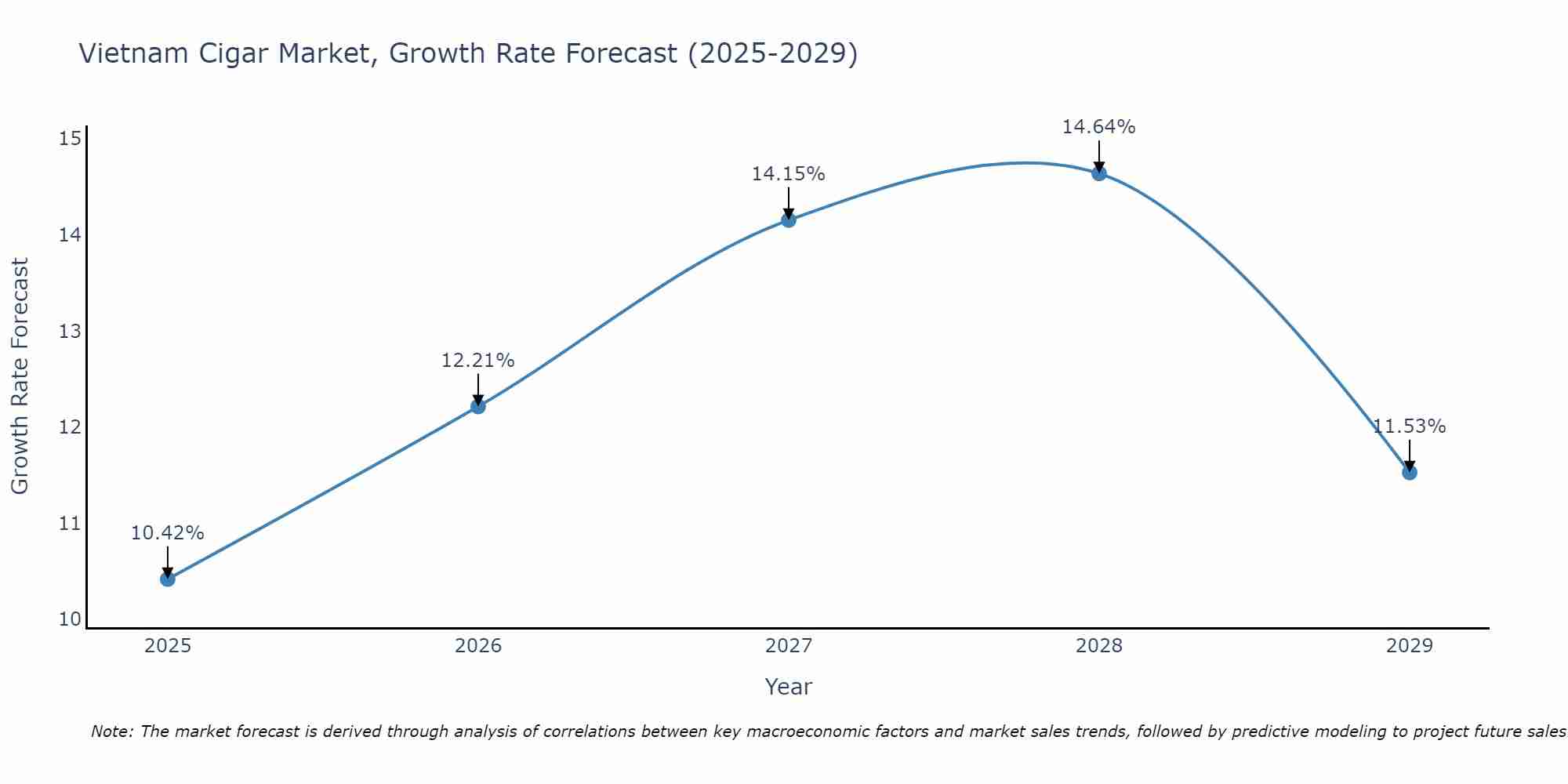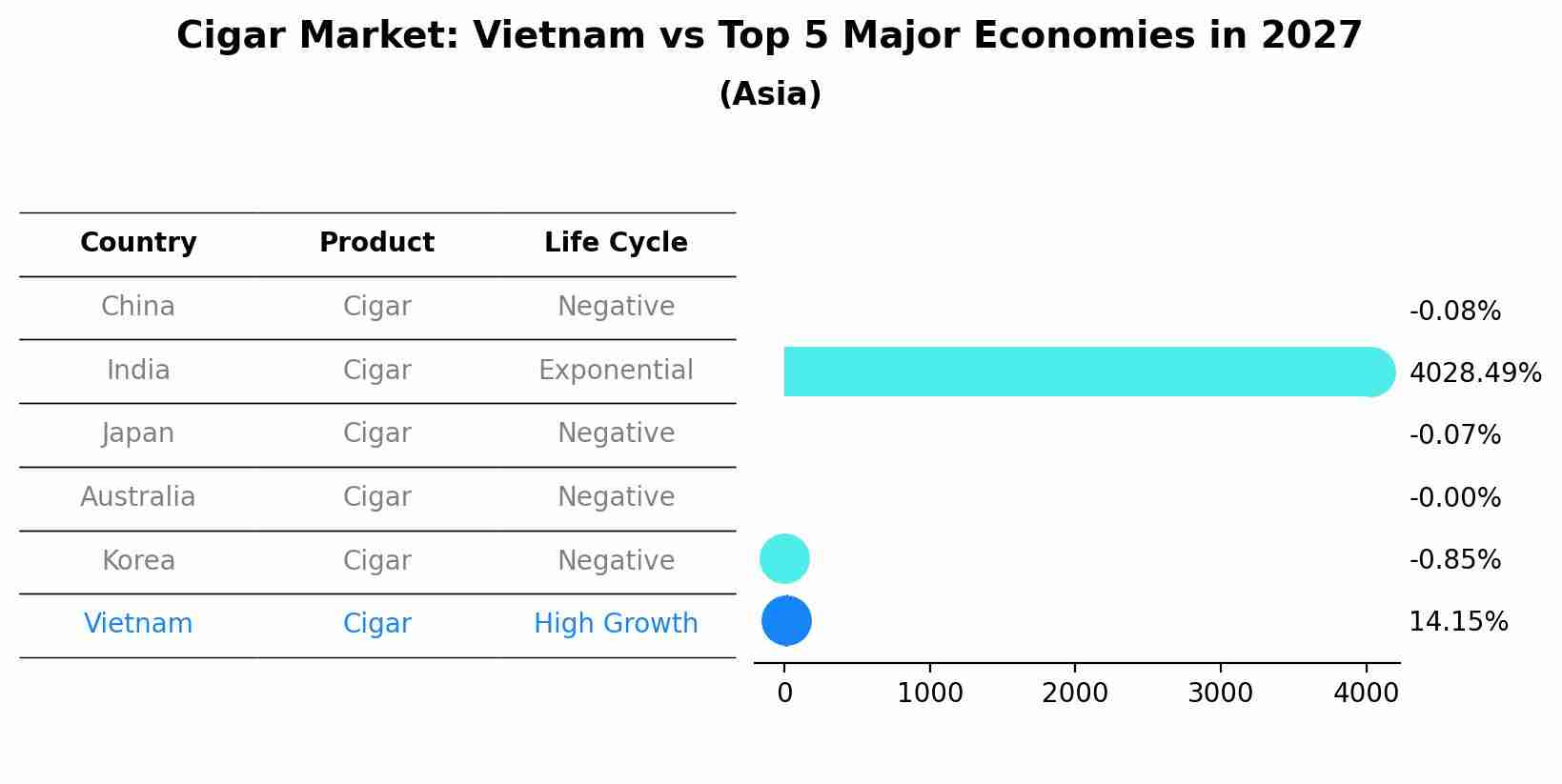Vietnam Cigar Market (2025-2031) Outlook | Forecast, Analysis, Revenue, Share, Trends, Industry, Size, Value, Companies & Growth
| Product Code: ETC090769 | Publication Date: Jun 2021 | Updated Date: Apr 2025 | Product Type: Report | |
| Publisher: 6Wresearch | Author: Ravi Bhandari | No. of Pages: 70 | No. of Figures: 35 | No. of Tables: 5 |
Vietnam Cigar Market Size Growth Rate
The Vietnam Cigar Market is projected to witness mixed growth rate patterns during 2025 to 2029. The growth rate begins at 10.42% in 2025, climbs to a high of 14.64% in 2028, and moderates to 11.53% by 2029.

Cigar Market: Vietnam vs Top 5 Major Economies in 2027 (Asia)
The Cigar market in Vietnam is projected to grow at a high growth rate of 14.15% by 2027, highlighting the country's increasing focus on advanced technologies within the Asia region, where China holds the dominant position, followed closely by India, Japan, Australia and South Korea, shaping overall regional demand.

Vietnam Cigar Market Overview
The Vietnam Cigar market is experiencing notable growth, driven by changing consumer preferences and an increasing interest in premium tobacco products. Cigars, traditionally associated with luxury and leisure, are gaining popularity among a diverse consumer base. The market is witnessing a shift towards premium and handcrafted cigars, with consumers willing to explore diverse flavors and experiences. Additionally, the growing disposable income and changing lifestyles contribute to the market`s positive outlook. The Vietnam Cigar market is characterized by the presence of both domestic and international cigar brands, with a focus on product innovation and branding. As the cigar culture continues to evolve in Vietnam, the market is poised for sustained growth.
Drivers of the Market
The Vietnam cigar market is driven by various factors, including evolving consumer preferences and an increasing demand for premium and exotic cigar products. Rising disposable income among the population has led to an expansion of the market, with consumers willing to explore high-end and luxury cigar options. Furthermore, a growing trend of cigar aficionados and social smoking has contributed to market growth. Regulatory changes and taxation policies have also impacted the market dynamics. The market`s future depends on how it adapts to changing consumer preferences, pricing strategies, and the influence of regulatory measures.
Challenges of the Market
The Vietnam Cigar Market confronts challenges related to health concerns and changing consumer preferences. Increasing awareness of the health risks associated with smoking has led to a decline in traditional tobacco product consumption. This, coupled with the rise of alternative products and changing consumer preferences, poses a challenge to the cigar market. To adapt, manufacturers may need to explore new product categories or focus on niche markets while navigating evolving regulations and taxation policies related to tobacco products.
COVID 19 Impact on the Market
The Vietnam Cigar Market has been impacted by the COVID-19 pandemic, witnessing changes in consumer preferences and disruptions in the distribution channels. The market, which caters to a niche consumer base, experienced fluctuations in demand during lockdowns and restrictions. However, as social and economic activities resume, the cigar market is expected to recover. The market`s trajectory post-COVID-19 may be influenced by factors such as changing consumer lifestyles, regulatory developments, and the overall economic recovery in the country.
Key Players in the Market
The Vietnam cigar market features a dynamic landscape with several key players contributing to its growth and competitiveness. One prominent player in this market is Vinataba Cigar JSC, known for its wide range of premium cigars and a strong market presence. Another significant contributor is Cigars International, a well-established brand recognized for its diverse cigar offerings and global reach. Additionally, Habanos S.A., a renowned Cuban cigar manufacturer, holds a notable position in the Vietnam market, offering high-quality cigars that appeal to discerning consumers. The presence of Davidoff, a Swiss company known for its luxury cigars, further enriches the market with its distinctive blends. These key players collectively shape the Vietnam cigar market, each bringing unique strengths and offerings to cater to the preferences of a diverse consumer base.
Key Highlights of the Report:
- Vietnam Cigar Market Outlook
- Market Size of Vietnam Cigar Market, 2024
- Forecast of Vietnam Cigar Market, 2031
- Historical Data and Forecast of Vietnam Cigar Revenues & Volume for the Period 2021-2031
- Vietnam Cigar Market Trend Evolution
- Vietnam Cigar Market Drivers and Challenges
- Vietnam Cigar Price Trends
- Vietnam Cigar Porter's Five Forces
- Vietnam Cigar Industry Life Cycle
- Historical Data and Forecast of Vietnam Cigar Market Revenues & Volume By Product Type for the Period 2021-2031
- Historical Data and Forecast of Vietnam Cigar Market Revenues & Volume By Conventional Cigar for the Period 2021-2031
- Historical Data and Forecast of Vietnam Cigar Market Revenues & Volume By Premium Cigar for the Period 2021-2031
- Historical Data and Forecast of Vietnam Cigar Market Revenues & Volume By Distribution Channel for the Period 2021-2031
- Historical Data and Forecast of Vietnam Cigar Market Revenues & Volume By Offline Retail Stores for the Period 2021-2031
- Historical Data and Forecast of Vietnam Cigar Market Revenues & Volume By Online Retail Stores for the Period 2021-2031
- Vietnam Cigar Import Export Trade Statistics
- Market Opportunity Assessment By Product Type
- Market Opportunity Assessment By Distribution Channel
- Vietnam Cigar Top Companies Market Share
- Vietnam Cigar Competitive Benchmarking By Technical and Operational Parameters
- Vietnam Cigar Company Profiles
- Vietnam Cigar Key Strategic Recommendations
Frequently Asked Questions About the Market Study (FAQs):
1 Executive Summary |
2 Introduction |
2.1 Key Highlights of the Report |
2.2 Report Description |
2.3 Market Scope & Segmentation |
2.4 Research Methodology |
2.5 Assumptions |
3 Vietnam Cigar Market Overview |
3.1 Vietnam Country Macro Economic Indicators |
3.2 Vietnam Cigar Market Revenues & Volume, 2021 & 2031F |
3.3 Vietnam Cigar Market - Industry Life Cycle |
3.4 Vietnam Cigar Market - Porter's Five Forces |
3.5 Vietnam Cigar Market Revenues & Volume Share, By Product Type, 2021 & 2031F |
3.6 Vietnam Cigar Market Revenues & Volume Share, By Distribution Channel, 2021 & 2031F |
4 Vietnam Cigar Market Dynamics |
4.1 Impact Analysis |
4.2 Market Drivers |
4.3 Market Restraints |
5 Vietnam Cigar Market Trends |
6 Vietnam Cigar Market, By Types |
6.1 Vietnam Cigar Market, By Product Type |
6.1.1 Overview and Analysis |
6.1.2 Vietnam Cigar Market Revenues & Volume, By Product Type, 2021-2031F |
6.1.3 Vietnam Cigar Market Revenues & Volume, By Conventional Cigar, 2021-2031F |
6.1.4 Vietnam Cigar Market Revenues & Volume, By Premium Cigar, 2021-2031F |
6.2 Vietnam Cigar Market, By Distribution Channel |
6.2.1 Overview and Analysis |
6.2.2 Vietnam Cigar Market Revenues & Volume, By Offline Retail Stores, 2021-2031F |
6.2.3 Vietnam Cigar Market Revenues & Volume, By Online Retail Stores, 2021-2031F |
7 Vietnam Cigar Market Import-Export Trade Statistics |
7.1 Vietnam Cigar Market Export to Major Countries |
7.2 Vietnam Cigar Market Imports from Major Countries |
8 Vietnam Cigar Market Key Performance Indicators |
9 Vietnam Cigar Market - Opportunity Assessment |
9.1 Vietnam Cigar Market Opportunity Assessment, By Product Type, 2021 & 2031F |
9.2 Vietnam Cigar Market Opportunity Assessment, By Distribution Channel, 2021 & 2031F |
10 Vietnam Cigar Market - Competitive Landscape |
10.1 Vietnam Cigar Market Revenue Share, By Companies, 2024 |
10.2 Vietnam Cigar Market Competitive Benchmarking, By Operating and Technical Parameters |
11 Company Profiles |
12 Recommendations |
13 Disclaimer |
- Single User License$ 1,995
- Department License$ 2,400
- Site License$ 3,120
- Global License$ 3,795
Search
Thought Leadership and Analyst Meet
Our Clients
Related Reports
- Germany Breakfast Food Market (2026-2032) | Industry, Share, Growth, Size, Companies, Value, Analysis, Revenue, Trends, Forecast & Outlook
- Australia Briquette Market (2025-2031) | Growth, Size, Revenue, Forecast, Analysis, Trends, Value, Share, Industry & Companies
- Vietnam System Integrator Market (2025-2031) | Size, Companies, Analysis, Industry, Value, Forecast, Growth, Trends, Revenue & Share
- ASEAN and Thailand Brain Health Supplements Market (2025-2031) | Strategy, Consumer Insights, Analysis, Investment Trends, Opportunities, Growth, Size, Share, Industry, Revenue, Segments, Value, Segmentation, Supply, Forecast, Restraints, Outlook, Competition, Drivers, Trends, Demand, Pricing Analysis, Competitive, Strategic Insights, Companies, Challenges
- ASEAN Bearings Market (2025-2031) | Strategy, Consumer Insights, Analysis, Investment Trends, Opportunities, Growth, Size, Share, Industry, Revenue, Segments, Value, Segmentation, Supply, Forecast, Restraints, Outlook, Competition, Drivers, Trends, Demand, Pricing Analysis, Competitive, Strategic Insights, Companies, Challenges
- Europe Flooring Market (2025-2031) | Outlook, Share, Industry, Trends, Forecast, Companies, Revenue, Size, Analysis, Growth & Value
- Saudi Arabia Manlift Market (2025-2031) | Outlook, Size, Growth, Trends, Companies, Industry, Revenue, Value, Share, Forecast & Analysis
- Uganda Excavator, Crane, and Wheel Loaders Market (2025-2031) | Strategy, Consumer Insights, Analysis, Investment Trends, Opportunities, Growth, Size, Share, Industry, Revenue, Segments, Value, Segmentation, Supply, Forecast, Restraints, Outlook, Competition, Drivers, Trends, Demand, Pricing Analysis, Competitive, Strategic Insights, Companies, Challenges
- Rwanda Excavator, Crane, and Wheel Loaders Market (2025-2031) | Strategy, Consumer Insights, Analysis, Investment Trends, Opportunities, Growth, Size, Share, Industry, Revenue, Segments, Value, Segmentation, Supply, Forecast, Restraints, Outlook, Competition, Drivers, Trends, Demand, Pricing Analysis, Competitive, Strategic Insights, Companies, Challenges
- Kenya Excavator, Crane, and Wheel Loaders Market (2025-2031) | Strategy, Consumer Insights, Analysis, Investment Trends, Opportunities, Growth, Size, Share, Industry, Revenue, Segments, Value, Segmentation, Supply, Forecast, Restraints, Outlook, Competition, Drivers, Trends, Demand, Pricing Analysis, Competitive, Strategic Insights, Companies, Challenges
Industry Events and Analyst Meet
Whitepaper
- Middle East & Africa Commercial Security Market Click here to view more.
- Middle East & Africa Fire Safety Systems & Equipment Market Click here to view more.
- GCC Drone Market Click here to view more.
- Middle East Lighting Fixture Market Click here to view more.
- GCC Physical & Perimeter Security Market Click here to view more.
6WResearch In News
- Doha a strategic location for EV manufacturing hub: IPA Qatar
- Demand for luxury TVs surging in the GCC, says Samsung
- Empowering Growth: The Thriving Journey of Bangladesh’s Cable Industry
- Demand for luxury TVs surging in the GCC, says Samsung
- Video call with a traditional healer? Once unthinkable, it’s now common in South Africa
- Intelligent Buildings To Smooth GCC’s Path To Net Zero


















